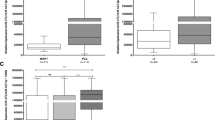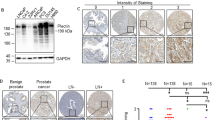Abstract
MicroRNAs (miRs) are a novel class of RNAs with important roles in regulating gene expression. To identify miRs controlling prostate tumor progression, we utilized unique human prostate sublines derived from the parental P69 cell line, which differ in their tumorigenic properties in vivo. Grown embedded in laminin-rich extracellular matrix (lrECM) gels these genetically-related sublines displayed drastically different morphologies correlating with their behaviour in vivo. The non-tumorigenic P69 subline grew as multicellular acini with a defined lumen and basal/polar expression of relevant marker proteins. M12, a highly tumorigenic, metastatic derivative, grew as a disorganized mass of cells with no polarization, whereas the F6 subline, a weakly tumorigenic, non-metastatic M12 variant, reverted to acini formation akin to the P69 cell line. These sublines also differed in expression of vimentin, which was high in M12, but low in F6 and P69 sublines. Analysis of vimentin’s conserved 3′-UTR suggested several miRs that could regulate vimentin expression. The lack of miR-17-3p expression correlated with an increase in vimentin synthesis and tumorigenicity. Stable expression of miR-17-3p in the M12 subline reduced vimentin levels 85% and reverted growth to organized, polarized acini in lrECM gels. In vitro motility and invasion assays suggested a decrease in tumorigenic behaviour, confirmed by reduced tumor growth in male athymic, nude mice dependent on miR-17-3p expression. Analysis of LCM-purified clinical human prostatectomy specimens confirmed that miR-17-3p levels were reduced in tumor cells. These results suggest that miR-17-3p functions as a tumor suppressor, representing a novel target to block prostate tumor progression.






Similar content being viewed by others
Abbreviations
- Chr19:
-
Chromosome 19
- EMT:
-
Epithelial mesenchymal transition
- FFPE:
-
Formalin-fixed paraffin embedded
- IFP:
-
Intermediate filament protein
- IPROS:
-
Intra-prostatic injection
- LCM:
-
Laser capture microdissection
- LrECM:
-
Laminin-rich extracellular matrix
- miR(s):
-
microRNA(s)
- nts:
-
Nucleotides
- qRT-PCR:
-
Quantitative real time-polymerase chain reaction
- 3D:
-
Three dimensional
- SC:
-
Subcutaneous
- SYBR Green:
-
Synergy brands green
References
Bartel DP, Chen CZ (2004) Micromanagers of gene expression: the potentially widespread influence of metazoan microRNAs. Nat Rev Genet 5:396–400
Zhao Y, Srivastava D (2007) A developmental view of microRNA function. Trends Biochem Sci 32:189–197
Lu J, Getz G, Miska EA et al (2005) MicroRNA expression profiles classify human cancers. Nature 435:834–838
Boehm M, Slack FJ (2006) MicroRNA control of lifespan and metabolism. Cell Cycle 5:837–840
Calin GA, Liu CG, Sevignani C et al (2004) MicroRNA profiling reveals distinct signatures in B cell chronic lymphocytic leukemias. Proc Natl Acad Sci USA 101:11755–11760
Calin GA, Dumitru CD, Shimizu M et al (2002) Frequent deletions and down-regulation of micro-RNA genes miR15 and miR16 at 13q14 in chronic lymphocytic leukemia. Proc Natl Acad Sci USA 99:15524–15529
Volinia S, Calin GA, Liu CG et al (2006) A microRNA expression signature of human solid tumors defines cancer gene targets. Proc Natl Acad Sci USA 103:2257–2261
Kent OA, Mendell JT (2006) A small piece in the cancer puzzle: microRNAs as tumor suppressors and oncogenes. Oncogene 25:6188–6196
Shi XB, Tepper CG, White VW (2008) MicroRNAs and prostate cancer. J Cell Mol Med 12(58):1456–1465
Bae VL, Jackson-Cook CK, Brothman AR et al (1994) Tumorigenicity of SV40 T antigen immortalized human prostate epithelial cells: association with decreased epidermal growth factor receptor (EGFR) expression. Int J Cancer 58:721–729
Bae VL, Jackson-Cook CK, Maygarden SJ et al (1998) Metastatic sublines of an SV40 large T antigen immortalized human prostate epithelial cell line. Prostate 34:275–282
Astbury C, Jackson-Cook CK, Culp SH et al (2001) Suppression of tumorigenicity in the human prostate cancer cell line M12 via microcell-mediated restoration of chromosome 19. Genes Chromosomes Cancer 31:143–155
Zhang X, Fournier M, Ware JL et al (2009) Inhibition of vimentin or β1-integrin reverts morphology of prostate tumor cells grown in laminin-rich extracellular matrix gels and reduces tumor growth in vivo. Mol Can Ther 8(3):499–508
Liu X, Wu Y, Zehner ZE et al (2003) Proteomic analysis of the tumorigenic human prostate cell line M12 after microcell-mediated transfer of chromosome 19 demonstrates reduction of vimentin. Electrophoresis 24:3445–3453
Lang SH, Hyde C, Reid IN et al (2002) Enhanced expression of vimentin in motile prostate cell lines and in poorly differentiated and metastatic prostate carcinoma. Prostate 52:253–263
Zhao Y, Yan Q, Long X et al (2008) Vimentin affects the mobility and invasiveness of prostate cancer cells. Cell Biochem Funct 26:571–577
Zehner ZE, Shepherd RK, Gabryszuk J et al (1997) RNA–protein interactions within the 3′ untranslated region of vimentin mRNA. Nucl Acids Res 25:3362–3370
Nilsen TW (2007) Mechanisms of microRNA-mediated gene regulation in animal cells. Trends Genet 23:243–249
Ambros V (2004) The function of animal microRNAs. Nature 431:350–355
Mendell JT (2008) miRiad roles for the miR-17–92 cluster in development and disease. Cell 133:217–222
Gurel B, Iwata T, Koh M et al (2008) Nuclear MYC protein overexpression is an early alteration in human prostate carcinogenesis. Mod Pathol 21:1156–1167
O’Donnell KA, Wentzel EA, Zeller KI et al (2005) c-Myc-regulated microRNAs modulate E2F1 expression. Nature 435:839–843
Thalmann GN, Anezinis PE, Chang SM et al (1994) Androgen-independent cancer progression and bone metastasis in the LNCaP model of human prostate cancer. Cancer Res 54:2577–2581
Yacoub A, McKinstry R, Hinman D et al (2003) Epidermal growth factor and ionizing radiation up-regulate the DNA repair genes XRCC1 and ERCC1 in Du145 and LNCaP prostate carcinoma through MAPK signaling. Radiat Res 159:439–452
Hegan M, Yacoub A, Dent P (2004) Ionizing radiation causes a dose-dependent release of transforming growth factor alpha in vitro from irradiated xenografts and during palliative treatment of hormone-refractory prostate carcinoma. Clin Cancer Res 10:5724–5731
Lee GY, Kenny PA, Lee EH et al (2007) Three-dimensional culture models of normal and malignant breast epithelial cells. Nat Methods 4:359–365
Zhang X, Diab IH, Zehner ZE (2003) ZBP-89 represses vimentin gene transcription by interacting with the transcriptional activator, Sp1. Nucl Acids Res 31:2900–2914
Chen C, Ridzon DA, Broomer AJ et al (2005) Real-time quantification of microRNAs by stem-loop RT–PCR. Nucleic Acids Res 33:e179
Livak KJ, Schmittgen TD (2001) Analysis of relative gene expression data using real-time quantitative PCR and the 2−ΔΔCT method. Methods 25:402–408
Gleason DF, Mellinger GΤ (1974) Prediction of prognosis for prostatic adenocarcinoma by combined histological grading and clinical staging. J Urol 111(1):58–64
Epstein JI, Yang XJ (2002) Prostate biopsy interpretation, 3rd edn. Lippincott Williams & Wilkins, Philadelphia, pp 54–176
Paccione RJ, Miyazaki H, Patel V et al (2008) Keratin downregulation in vimentin-positive cancer cells is reversible by vimentin RNAi, which inhibits growth and motility. Mol Cancer Ther 7:2898–2903
Larkin MA, Blackshields G, Brown NP et al (2007) Clustal W and Clustal X version 2.0. Bioinformatics 23:2947–2948
Bermano G, Shepherd RK, Zehner ZE et al (2001) Perinuclear mRNA localisation by vimentin 3′-untranslated region requires a 100 nucleotide sequence and intermediate filaments. FEBS Lett 497:77–81
Griffiths-Jones S, Grocock RJ, vanDongen S et al (2006) miRBase: microRNA sequences, targets and gene nomenclature. Nucl Acids Res 34:D140–D144
Chiosea S, Jelezcova E, Chandran U et al (2006) Up-regulation of dicer, a component of the MicroRNA machinery in prostate adenocarcinoma. Am J Pathol 169:1812–1820
Singh S, Sadacharan S, Su S et al (2003) Overexpression of vimentin: role in the invasive phenotype in an androgen-independent model of prostate cancer. Cancer Res 63:2306–2311
Eckes B, Dogic D, Colucci-Guyon E et al (1998) Impaired mechanical stability, migration and contractile capacity in vimentin-deficient fibroblasts. J Cell Sci 111:1897–1907
Weaver VM, Petersen OW, Wang F et al (1997) Reversion of the malignant phenotype of human breast cells in three-dimensional culture and in vivo by integrin blocking antibodies. J Cell Biol 137:231–245
Li J, Smyth P, Flavin R et al (2007) Comparison of miRNA expression patterns using total RNA extracted from matched samples of formalin-fixed paraffin-embedded (FFPE) cells and snap frozen cells. BMC Biotechnol 29(7):36
Doleshal M, Magotra AA, Choudhury B (2008) Evaluation and validation of total RNA extraction methods for microRNA expression analyses in formalin-fixed, paraffin-embedded tissues. J Mol Diagn 10(3):203–211
Miranda KC, Huynh T, Tay Y et al (2006) A pattern-based method for the identification of microRNA binding sties and their corresponding heteroduplexes. Cell 126:1203–1217
Nishida M, Kato M, Kato Y et al (2007) Identification of ZNF200 as a novel binding partner of histone H3 methyltransferase G9a. Genes Cells 12:877–888
Raiborg C, Stenmark H (2009) The ESCRT machinery in endosomal sorting of ubiquitylated membrane proteins. Nature 458:445–452
Walter M, Chen FW, Tamari F et al (2009) Endosomal lipid accumulation in NPC1 leads to inhibition of PKC, hypophosphorylation of vimentin and Rab9 entrapment. Biol Cell 101:141–152
Chaurand P, Rahman MA, Hunt T et al (2008) Monitoring mouse prostate development by profiling and imaging mass spectrometry. Mol Cell Proteomics 7:411–423
Choi KJ, Piao YJ, Lim MJ et al (2007) Overexpressed cyclophilin A in cancer cells renders resistance to hypoxia- and cisplatin-induced cell death. Cancer Res 67:3654–3662
Legros F, Lombes A, Frachon P et al (2002) Mitochondrial fusion in human cells is efficient, requires the inner membrane potential, and is mediated by mitofusins. Mol Biol Cell 13:4343–4354
Chen H, Detmer SA, Ewald AJ et al (2003) Mitofusions Mfn1 and Mfn2 coordinately regulate mitochondrial fusion and are essential fro embryonic development. J Cell Biol 160:189–200
Birkenfeld J, Nalbant P, Bohl BP et al (2007) GEF-H1 modulates localized RhoA activation during cytokinesis under the control of mitotic kinases. Devel Cell 12:699–712
Chang Y-C, Nalbant P, Birkenfeld J (2009) GEF-H1 couples nocodazole-induced microtubule disassembly to cell contractility via RhoA. Mol Biol Cell 19:2147–2153
Kuhn DE, Martin MM, Feldman DS et al (2008) Experimental validation of miRNA targets. Methods 44:47–54
Eckes B, Colucci-Guyon E, Smola H et al (2000) Impaired wound healing in embryonic and adult mice lacking vimentin. J Cell Sci 113:2455–2462
Gaur A, Jewell DA, Liang Y et al (2007) Characterization of microRNA expression levels and their biological correlates in human cancer cell lines. Cancer Res 67:2456–2468
Ozen M, Creighton CJ, Ozdemir M et al (2008) Widespread deregulation of microRNA expression in human prostate cancer. Oncogene 27:1788–1793
Porkka KP, Pfeiffer MJ, Waltering KK et al (2007) MicroRNA expression profiling in prostate cancer. Cancer Res 67:6130–6135
Ambs S, Prueitt RL, Yi M et al (2008) Genomic profiling of microRNA and mRNA reveals deregulated microRNA expression in prostate cancer. Cancer Res 68:6162–6170
McNamara JO, Andrechek ER, Wang Y et al (2006) Cell type-specific delivery of siRNAs with aptamer-siRNA chimerase. Nat Biotechnol 24:1005–1015
Acknowledgments
We would like to thank Ms. Frances K. White and the confocal imaging facility from the Massey Cancer Center supported in part by NIH Grant P30CA16059, Dr. Stephen Plymate for the LNCaP-L, C4, and C4-2 cell lines, and Dr. Adly Yacoub for LNCaP-A and xenograft LNCaP-F2 cells. Grant support was from the Commonwealth Health Research Board (CHRB) to ZEZ.
Author information
Authors and Affiliations
Corresponding author
Rights and permissions
About this article
Cite this article
Zhang, X., Ladd, A., Dragoescu, E. et al. MicroRNA-17-3p is a prostate tumor suppressor in vitro and in vivo, and is decreased in high grade prostate tumors analyzed by laser capture microdissection. Clin Exp Metastasis 26, 965–979 (2009). https://doi.org/10.1007/s10585-009-9287-2
Received:
Accepted:
Published:
Issue Date:
DOI: https://doi.org/10.1007/s10585-009-9287-2




